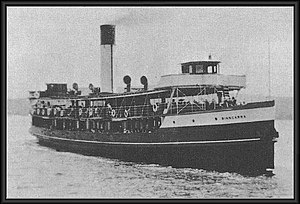 Binngarra on Sydney Harbour
| |
| History | |
|---|---|
| Name | Binngarra |
| Operator | Port Jackson & Manly Steamship Company |
| Port of registry | Sydney |
| Route | Manly |
| Builder | Mort's Dock and Engineering |
| Cost | £23,564 |
| Launched | 18 July 1905 |
| Maiden voyage | 29 October 1905 |
| Out of service | 1930 |
| Fate | Scuttled 11 December 1946 |
| General characteristics | |
| Class and type | Binngarra-class ferry |
| Tonnage | 442 tons |
| Length | 58.1 m (190 ft 7 in) |
| Beam | 9.7 m (31 ft 10 in) |
| Height | 4.1 m (13 ft 5 in) |
| Draught | 3.45 m (11 ft 4 in) |
| Decks | 2 |
| Installed power | 103 NHP, 1,150 ihp (860 kW) |
| Propulsion | 3 cylinder tripled expansion steam engines |
| Speed | 13 knots (24 km/h; 15 mph) |
| Capacity | 1,372 passengers (fair weather), 858 (rough weather) |
| Crew | 11 |
Binngarra was a ferry operated by Port Jackson & Manly Steamship Company on the Manly service. Launched in 1905, she was the first of six similar vessels built for the company–the Binngarra class—the success of which saw three of her sister vessels serving through to the 1970s and 1980s.
Built by Mort's Dock and Engineering Co Ltd, in Woolwich, she was a double-ended screw steamer with steel hull and timber superstructure. She was decommissioned from ferry service in 1930.
"Binngarra" is thought to be an Australia Aboriginal word for "spring" or "returning". It is sometimes misspelled as "Bingarra".